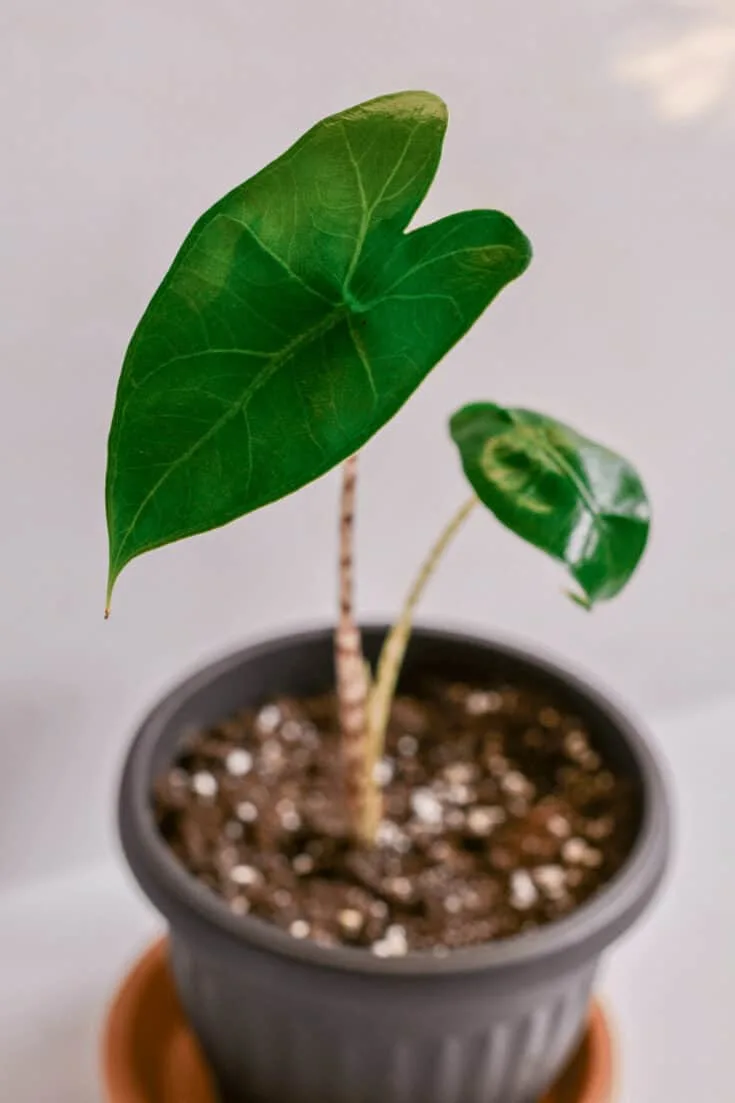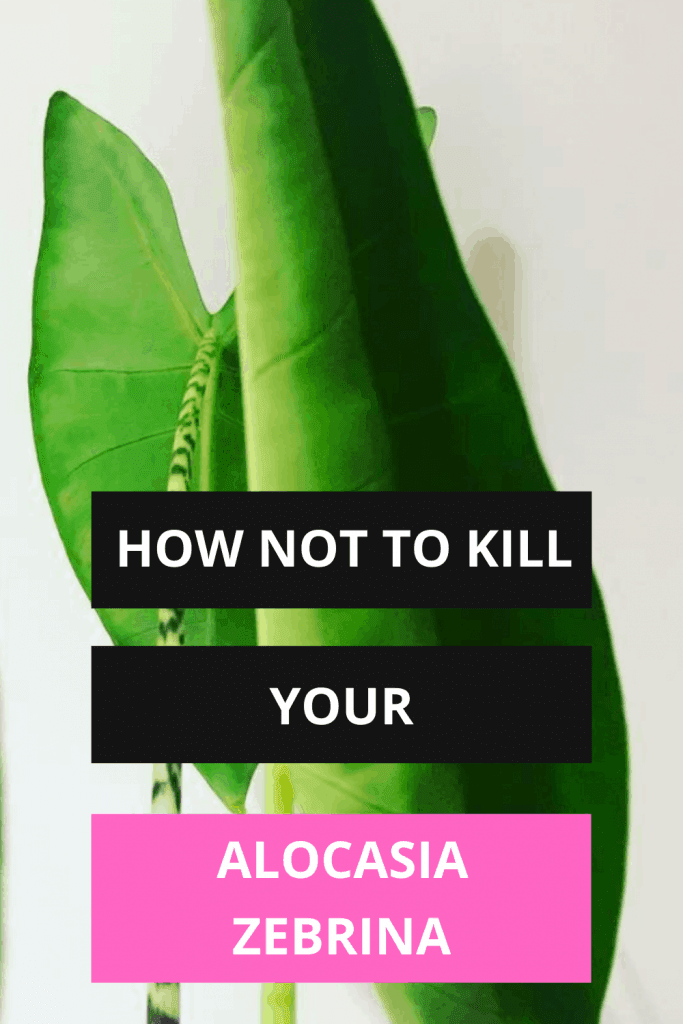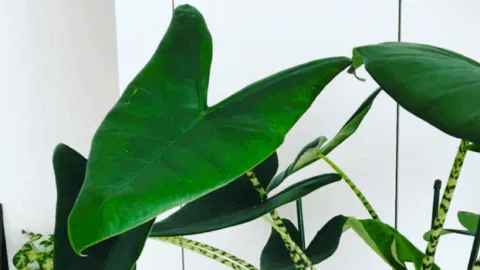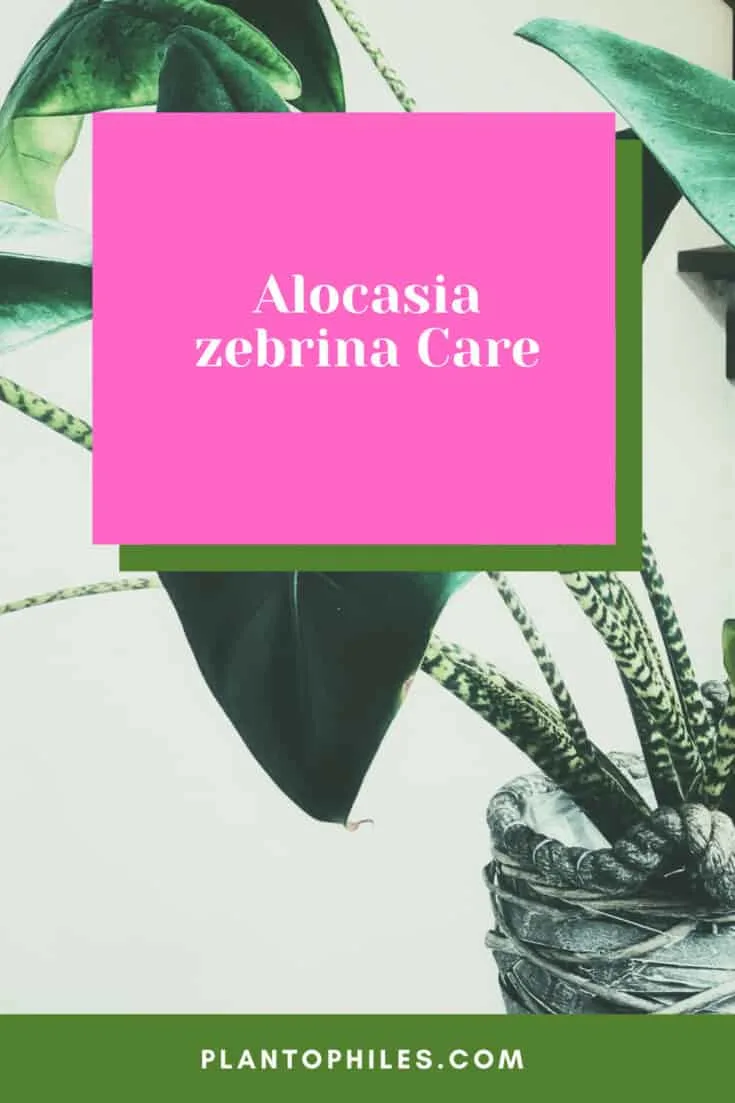The Alocasia zebrina is a tropical plant with large leaves.
It is mainly prized for its ornamental stems and not its flowers or leaves.
Its large leaves stand out and are beautiful but its zebra-patterned stems are truly unique and really become the focal point.
This tropical plant is from Southeast Asia and the Philippines originally but has become quite popular among houseplants.
It grows to about three feet high and three feet wide and during the warm season is considered fast-growing.
With ideal growing conditions, it can put out leaves every two weeks.
These Alocasia naturally grow on the jungle floor in humid conditions.
They sometimes go by the nickname ‘Elephant Ears’ due to their large elephant ear-shaped leaf.
According to the University of Florida, in the wild, these plants are quite invasive and will spread to cover large areas.
In the wild, they have pretty flowers but they are not commonly known for flowering when they are a houseplant.
Alocasia zebrina Care
Alocasia zebrina care starts with the right soil that needs to be well-draining. Use a mix of peat, perlite, and potting soil. Water once the top 2” (5 cm) of soil dry out about once a week. A temperature between 65-77°F (18-25°C) works best. A humidity of 60% or great is optimal.
Table of Contents
Alocasia Zebrina Plant Care Basics
Soil
An Alocasia zebrina needs extremely well-draining soil.
I use equal parts of perlite, peat, and compost for mine and it works extremely well.
Light
Alocasia zebrina prefers bright indirect sunlight.
They are a reaching plant and if they don’t get enough sunlight, the stalks will grow too long to try and reach the sun.
They also tend to lean towards the sun, so a good practice is to rotate it a quarter turn each time you water to prevent that from happening.
Direct sunlight for a long period can scorch the leaves.
Watering
Water Alocasia Zebrina once the top 2” (5 cm) of soil completely dry out.
Alocasia zebrina’s prefer slightly drier soil which is why it is so important to have well-draining soil.
It will allow the excess water out.
Always make sure your plant has adequate draining holes in the bottom as well.
This can prevent root rot and death if the plant is overwatered.
Ideally, for the best Alocasia zebrina care, you want to water it once a week approximately.
I let the top two inches of soil dry out before I water it and when I do water it, I lift the plant and wait for the water to come out of the bottom drainage holes.
If the Alocasia zebrina is left to dry out too much the edges of the leaves can get brown.

Alocasia zebrina produces tubers where they store their energy. So even if they lose all leaves they can bounce back.
Temperature
For proper Alocasia zebrina care, the temperature should be between 65-77 degrees Fahrenheit (18-25 degrees Celsius).
It is best to avoid abrupt temperature changes as well as hot and cold drafts, including direct heat sources or air conditioning.
It is not frost tolerant.
Humidity
It is best to have a humid environment of around 60% humidity for Alocasia zebrina.
I keep a tray filled with water and pebbles beneath mine to ensure that the environment is humid enough for it.
This plant also benefits from regular leaf misting. I mist mine every second day.
Fertilizer
The Alocasia zebrina grows rapidly from spring to fall and it is best to fertilize every two weeks in that time.
I fertilize mine once every two months or so during the non-growing season.
Flowers
The “flowers” on the Alocasia zebrina may be seen on occasion, however, as a potted container plant, this is not a common sight.
Don’t expect any large beautiful blooms here. The Alocasia zebrina is grown for its foliage.
The stunning leaves are therefore the main attraction of this plant, the flowers being an afterthought if they do arrive.
Opinion on how to treat the long stem of the flowers when it appears is split.
Whilst there’s no harm to let it flower, many keen Alocasia variety enthusiasts claim it is better to remove any signs of this.
The reason for this preference is clear.
Flowering, no matter how non-descript – as in the case of the Alocasia zebrina – takes a lot of effort for a plant.
As a result, some of the leaves may become brown in appearance or develop other unhealthy signs.
As the plant is prized for its leaves, the preference is generally to remove the flowers at the first sign.
This will leave the plant free to focus on the health of the leaves.
If you do want to let the plant flower – go ahead. You will see a long stalk develop with a hooded green spathe at the top.
Inside, a white spadix will appear.
This is actually a collection of really tiny flowers.
The display will generally last around one month.
In the wild, this usually happened in spring, but indoors it can be random.
Eventually, it will brown and fall off, you can remove it if it bothers you at this point.

All Credit for this picture of the Alocasia zebrina as well as the picture in the featured image of this article go to @chlorophyll_frenzy on Instagram! Check her Insta page out for more beautiful pictures of houseplants!
Propagation
Alocasia zebrina propagation can be done by separating the tubers that grow in the soil.
Alocasia zebrina plants are tuberous and because of this, it is not suitable to propagate with cuttings from the plant.
The plant grows bulbs at its roots and the clumping bulbs can be separated and propagated in that manner instead.
It is a fairly easy process and they grow very well. I’ve outlined the process below in detail.
Growth
Alocasia Zebrina can grow up to 3-feet (92 cm).
Mine is currently three feet tall and almost as wide which is generally the largest size they grow to.
They can also grow many offshoots all in the same pot as they are a fairly invasive species in the wild.
They will literally cover the floor of the jungle in some areas.
Potting and repotting
The Alocasia zebrina prefers to be in a pot only slightly bigger than its roots.
To give my Alocasia zebrina care, I use a plastic or ceramic pot with plenty of drainage holes in the bottom. This prevents overwatering as the excess water drains out.
This type of plant should not be put in a pot much larger than its root system so choose a pot that is only an inch or two bigger than the roots.
It is best to avoid repotting this plant because it is easy to damage its delicate roots.
Only repot if the plant is extremely root bound and don’t move it into a substantially bigger pot.
I always propagate mine when I repot it as well to prevent from stressing the plant out too many times.
Alocasia zebrina Propagation Step-By-Step
- The best time to propagate your Alocasia zebrina is when you must repot it anyway.
- The first thing to do it to remove the plant from the pot and to gently shake off the excess dirt. Sometimes if the dirt is very clumped, I’ll soak it for a few minutes in water to free it up.
- Once the roots are exposed, you can see the multiple growth clumps. Likely there will be some offsets (baby plants) as well. Although it is all connected, you can gently separate the clumps with your fingers or a disinfected pair of scissors or a knife.
- The separated clumps should grow in either soil or water with the proper Alocasia zebrina care. Simply plant them in a prepared pot with proper drainage and a rich easily draining soil or clean the soil off and put the separated plants in a vase filled with water. If you use tap water, make sure it sits for 24 hours before doing this to remove the chlorine. I do this when I water my plants as well.
Alocasia zebrina Common Plant Pests
If the Alocasia zebrina care is off, the plant can get leaf spot diseases and root rot.
It can also be susceptible to mealybugs, spider mites, aphids, and scale sometimes.
Check the underside of the leaves for pests, particularly spider mites. I use a bit of Neem oil on the leaves to get rid of any pests.
The leaves can also be washed with an insecticidal soap and water mixture.
Alocasia zebrina Care Tips & Tricks
As I mentioned above, before you water your Alocasia zebrina, let the water sit for at least 24 hours (that is when using tap water!) to remove any chlorine as these plants are very sensitive to minerals and sodium in their water.
An alternative to this is to use a water filter system to filter the water you give your plants beforehand.
One of the tricks I use when watering all my plants is to lift the pot in between watering to test its weight.
I wait till the plant is dry and lift it. Then I water and lift again.
For me, this is an easy trick to knowing how much water is left in the pot based on weight.
I also do the finger check of course, but the weight one is a good estimator as well.
Alocasia zebrina Potential Problems
Yellowing or spotting on the leaves can indicate that your Alocasia zebrina has been overwatered.
Make sure you allow the top to dry out completely before watering again.
This is especially true in the winter months when the plant is dormant and not in its growth period.
If the leaves of your Alocasia zebrina have brown on the edges it usually means that the plant has been underwatered or the leaves have been scorched by direct sunlight.
Check the soil and if needed move it to a brightly lit room but not into the direct sunlight.
Alocasia zebrina Droopy Leaves
Sometimes the leaves will droop on an Alocasia zebrina and this can mean that the Alocasia zebrina care needs to be adjusted.
Is it being overwatered or underwatered or are there insufficient nutrients in the soil?
Consider the time of the year that it is and remember that these plants are fast-growing in the summer and spring and require weekly feedings of fertilizer.
Check the soil regularly and flush it every few months to prevent fertilizer buildup.
The other reasons for droopy leaves are that the plant is not close enough to a light source or it is severely root-bound.
I always consider these things when I am troubleshooting drooping leaves on my Alocasia zebrina.
Uneven distribution of light
As I mentioned above, sometimes to give your Alocasia zebrina care, it will need to be rotated at watering.
This plant craves light and will grow in the direction of the sun.
If you see this happening, rotate the plant a ¼ turn every time you water.
This will prevent it from reaching effect and will make sure that the light your Alocasia zebrina is getting is evenly distributed.
Stem bending
There are a couple of reasons the stems may be beginning to bend on your Alocasia zebrina.
This is a sign of distress, and as it is a little bit of a fussy plant you need to act quickly to any signs of droop.
One reason for this behavior is inadequate access to light.
Although it shouldn’t be in direct sunlight, you should move it so it has as much exposure to indirect sunlight as possible.
If you don’t, the stalks will try to search for the light, which can result in drooping, bending and the plant losing a defined shape.
Another reason could be root rot – caused by a combination of overwatering and incorrect soil or poor drainage conditions.
If your soil is waterlogged, there is likely not enough oxygen getting to the roots of the plant.
This too will cause it to begin to droop, and could expose the plant also to a fungal infection, which could be deadly.
Check for soggy soil frequently, or drooping combined with changes to the leaves.
There is one occasion however where drooping leaves are acceptable for your Alocasia zebrina.
That is, if your plant is entering a dormancy period.
This would naturally be in the winter months, but could also be anytime when it has reduced light.
If you have an otherwise healthy plant and it has gone into dormancy, then drooping leaves can be expected.
If you are confident that there are no other systemic issues with the plant, then this may be the reason for drooping leaves.
Alocasia zebrina Dormancy
During the winter months, even in a household environment, it is likely that your Alocasia zebrina will be exposed to lower temperatures and light levels.
This usually results in the plant – especially in the wild – entering a dormancy period.
This can cause it to look less desirable than normal. Of course, this can be disappointing if you have the plant on display for aesthetic purposes.
Luckily in a controlled indoor environment, you can try to help the Alocasia zebrina through the winter looking its best.
Move it to an area that gets more light, and try to keep the temperature raised slightly.
No matter what you do during this period, the leaves and stems will likely begin to perk up in the spring.
Dormancy will usually be kicked off if temperatures get to around 65 degrees Fahrenheit and below.
If you think about the natural environment of the plant – tropical, warm, with daily showers of warm rain, it can be hard to replicate the conditions required to avoid dormancy.
The Alocasia range of plants seems to require warmth also from the bottom up during this period.
You can purchase heating mats online for plants. You could try one of those and see if it does the trick.
One thing to note in the dormancy period – if you decide to let it happen. The plant will have stopped growing.
So it will be very important for you to adapt the watering schedule.
You will need to ease up on the watering during this period so you do not overwater and kill the plant. Keep the soil almost dry, just very slightly moist.
Frequently Asked Questions About Alocasia zebrina
Where can I buy an Alocasia zebrina plant?
You don’t have to make any special trips for this plant. They are available regularly at the garden and home gardening stores. Alocasia zebrina is also available at Amazon.
Does my Alocasia zebrina care need to include regular pruning?
Alocasia zebrina requires very little pruning. Removing unhealthy leaves from any plant is a good idea. With an Alocasia zebrina’s the leaves that are dead and wilted should be removed if they haven’t fallen off already. Most of the time the plant sheds them naturally though so I find they don’t need much more than that.
Are Alocasia zebrina toxic to animals?
Alocasia zebrina is toxic to animals. Animals or small children should not chew on the foliage or stems. The sap from inside the stems can cause a rash if it comes in to contact with the skin as well so use extra caution with these plants around animals. I keep mine out of reach and in a room my pets don’t go into. If you suspect that a child or pet has ingested any of this plant, call poison control or get the animal to an emergency vet as soon as possible.
The leaves on my Alocasia zebrina are drying and falling off in the winter. Is this normal?
Although it is important to check the soil for proper watering, a lot of the time the leaves fall off when Alocasia zebrina is in its dormant phase. The best course of action is to reduce the watering schedule. Always remember to check the moistness of the soil before changing the schedule though.
My Alocasia zebrina lost all its leaves. Is it dead?
Although it is not a good sign when an Alocasia zebrina loses all its leaves, it does not mean it is dead. They can bounce back as they reserve energy in their thick tubers. If it is summer, I will occasionally put mine on the patio on bright days in the shade for a few hours. This has helped me bring mine back more than once.
Alocasia zebrina Plant Care: Conclusion
Alocasia zebrina care can be somewhat challenging but once you troubleshoot the issues, it is a lot easier.
The end result of owning this beautiful plant is a large plant with huge leaves and stunning stalks.
It is a talking piece for sure. They are from Asia and require light but not direct sunlight and high humidity.
Most of the time they need to be misted every second day for optimal care and growth.
They are a wonderful addition to any indoor plant room and are becoming more and more common because of their stunning visual and sculptural appeal.
Alocasia zebrina’s can be propagated by separating the clumps or the rhizomes when you are repotting.
This is an excellent way to get more plants without buying new ones.
Just remember to keep them out of reach of any small children or pets as they are quite toxic if ingested.
Even the sap can cause a skin rash if it comes into contact with it.
Whether you decide to have one of these plants or many, they are guaranteed to be a great visual addition to any house!

Daniel has been a plant enthusiast for over 20 years. He owns hundreds of houseplants and prepares for the chili growing seasons yearly with great anticipation. His favorite plants are plant species in the Araceae family, such as Monstera, Philodendron, and Anthurium. He also loves gardening and is growing hot peppers, tomatoes, and many more vegetables.



